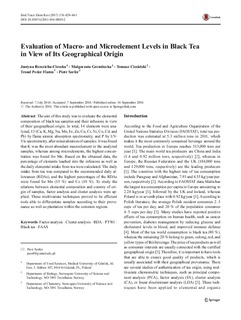| dc.contributor.author | Brzezicha-Cirocka, Justyna | |
| dc.contributor.author | Grembecka, Małgorzata | |
| dc.contributor.author | Ciesielski, Tomasz Maciej | |
| dc.contributor.author | Flaten, Trond Peder | |
| dc.contributor.author | Szefer, Piotr | |
| dc.date.accessioned | 2017-11-06T08:10:29Z | |
| dc.date.available | 2017-11-06T08:10:29Z | |
| dc.date.created | 2016-10-12T12:57:46Z | |
| dc.date.issued | 2016 | |
| dc.identifier.citation | Biological Trace Element Research. 2016, 176 429-441. | nb_NO |
| dc.identifier.issn | 0163-4984 | |
| dc.identifier.uri | http://hdl.handle.net/11250/2464105 | |
| dc.description.abstract | The aim of this study was to evaluate the elemental composition of black tea samples and their infusions in view of their geographical origin. In total, 14 elements were analyzed, 13 (Ca, K, Mg, Na, Mn, Fe, Zn, Cu, Cr, Ni, Co, Cd, and Pb) by flame atomic absorption spectrometry, and P by UV-Vis spectrometry, after mineralization of samples. It was found that K was the most abundant macroelement in the analyzed samples, whereas among microelements, the highest concentration was found for Mn. Based on the obtained data, the percentage of elements leached into the infusions as well as the daily elemental intake from tea were calculated. The daily intake from tea was compared to the recommended daily allowances (RDAs), and the highest percentages of the RDAs were found for Mn (15 %) and Co (10 %). To study the relations between elemental composition and country of origin of samples, factor analysis and cluster analysis were applied. These multivariate techniques proved to be efficient tools able to differentiate samples according to their provenance as well as plantation within the common regions. | nb_NO |
| dc.language.iso | eng | nb_NO |
| dc.publisher | Springer Verlag | nb_NO |
| dc.rights | Navngivelse 4.0 Internasjonal | * |
| dc.rights.uri | http://creativecommons.org/licenses/by/4.0/deed.no | * |
| dc.title | Evaluation of Macro- and Microelement Levels in Black Tea in View of Its Geographical Origin | nb_NO |
| dc.type | Journal article | nb_NO |
| dc.type | Peer reviewed | nb_NO |
| dc.description.version | publishedVersion | nb_NO |
| dc.source.pagenumber | 429-441 | nb_NO |
| dc.source.volume | 176 | nb_NO |
| dc.source.journal | Biological Trace Element Research | nb_NO |
| dc.identifier.doi | 10.1007/s12011-016-0849-2 | |
| dc.identifier.cristin | 1391204 | |
| dc.description.localcode | © The Author(s) 2016. Open access. This article is distributed under the terms of the Creative Commons Attribution 4.0 International License (http://creativecommons.org/licenses/by/4.0/) | nb_NO |
| cristin.unitcode | 194,66,10,0 | |
| cristin.unitcode | 194,66,25,0 | |
| cristin.unitname | Institutt for biologi | |
| cristin.unitname | Institutt for kjemi | |
| cristin.ispublished | true | |
| cristin.fulltext | postprint | |
| cristin.qualitycode | 1 | |

